Snow White and the Seven Adaptations
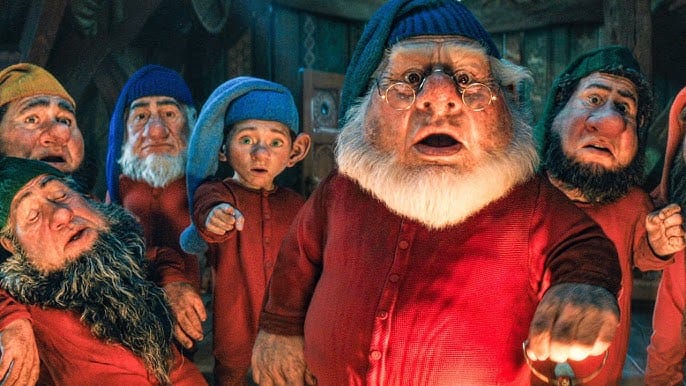
Greetings, friends. True to my word, after my previous glance into the abyss I needed a change of focus, from crimes against humanity to crimes against art. Disney's under-performing Snow White demake was an easy target, so I decided to make things more interesting by comparing it not just to its classic 1937 predecessor, but also to other live-action adaptations. Five of them came out all in 2012, and covering them provided an interesting survey of the modern film industry.
I. Off to Work We Go
Snow White and the Seven Dwarfs
(dir. David Hand, Perce Pearce, William Cottrell, Larry Morey, Wilfred Jackson, Ben Sharpsteen; 1937)
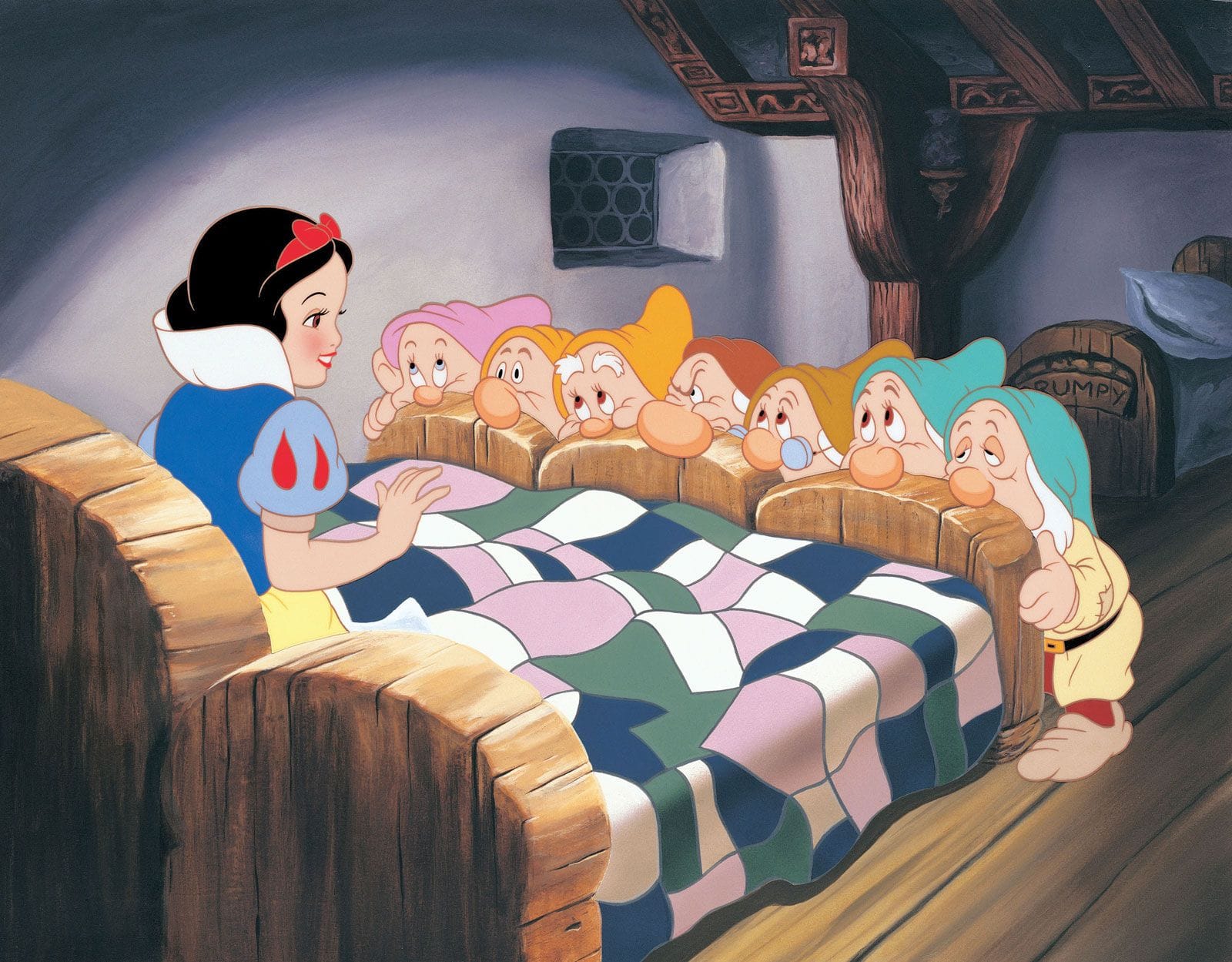
As the first-ever full-length animated feature, Snow White and the Seven Dwarfs earns its masterpiece status. The dwarves, animals, and the Queen as the old crone are so expressive they easily compensate for the occasional stiffness of the rotoscoped human characters. The score and animation are choreographed to a level that must have been daunting to do at this scale in the 1930s. The sparingly used horror imagery is incredibly effective, and there is also an early shot of a deer in a forest with a reflection in a pond that is so beautiful it brings me to tears. Technically it's unimpeachable.
It's in the narrative and pacing that Snow White shows its age. Does this need a plot summary? Fine. The Evil Queen (Lucile La Verne) is told by her magic mirror that her put-upon stepdaughter Snow White (Adriana Caselotti) is the fairest maiden in all the land, and so she dispatches a huntsman to kill her and bring back her heart. Instead he spares the young girl, and in the woods she happens on the home of seven friendly dwarfs and becomes a mother-figure to them. Learning Snow White yet lives the Queen transforms herself into an old crone and tricks her into eating a poisoned apple. The dwarfs and the entire forest chase her up and off a stormy cliff, then mourn the loss of the fair lass until a charming prince kisses her and brings her back to life. It's simple and effective, but not enough to sustain a feature on its own.
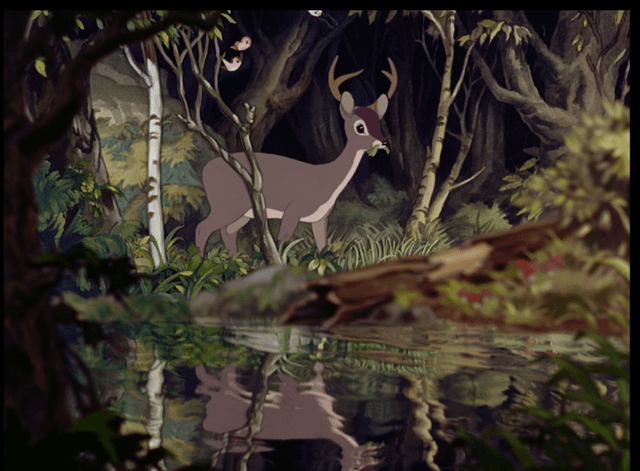
The directness of the storytelling makes for a brisk pace, up until the middle half hour when the dwarfs enter the picture. Their themed characterizations, Dopey, Sleepy, Bashful, etc etc are the source of countless gags, all well-executed. Nothing really happens, though, and the movie becomes so much more engaging once it regains dramatic momentum.
The body horror of the Queen's transformation, the dramatic slashing rain and lighting of the chase, the funeral-turned-resurrection in the forest clearing, all of these remain incredible sequences.
The unhurried middle feels like the work of a studio still most experienced in doing variations on a good gag for a few minutes at a time.
Everything Walt Disney's animators did here would be bettered later, with none of the mid-film dragginess and the insipid characterization of Snow White herself that makes me less enthusiastic about this. But it is still a milestone achievement. Nearly a century later it remains the best-known and arguably the best adaptation of the Grimm Brothers' 1812 Schneewittchen, even though it does sand away the story's stranger, more morbid edges. The 1937 film maintains the elegant, elemental simplicity of a fairy tale, and so too does the best of the 2012 adaptations, which draws from even older cinematic traditions.
II. Snow Black-and-White
Blancanieves
(dir. Pablo Berger, 2012)

The Snow White story is so well-known that, similar to Shakespeare, new takes on the material tend to transplant it into entirely new contexts. Blancanieves is no different, setting it in the world of 1930s Spanish bullfighting: our Snow White this time is Carmen 'Carmencita' Villalta (Sofía Oria as a child, Macarena García as an adult), daughter to famed matador Antonio Villalta (Daniel Giménez Cacho), who is gored and paralyzed the day she is born and her mother (Inma Cuesta) dies in childbirth. Antonio is ensnared by diabolical nurse Encarna (Maribel Verdú), who appropriates his property and, once he is gone, attempts to have Carmen murdered. She escapes, barely, and is discovered by a troup of bullfighting dwarfs.
This is already unique among Snow White stories, but it doesn't stop there. Befitting its setting, the movie is in wordless black-and-white, and though not shot on actual film stock, it uses the classic Academy aspect ratio (or something close to it, I've seen 1.34 and 1.38 along with 1.33:1). Fetishistically styling it like old and unfashionable films might suggest a stuffy art house affair, but this gets it exactly backwards. The techniques are old, but they are also simple and immediate: the lack of color streamlines the visual scheme to darkness and light, and where the modern widescreen format favors vast landscapes and camera movement, the more compact aspect ratio makes for bold and focused images.
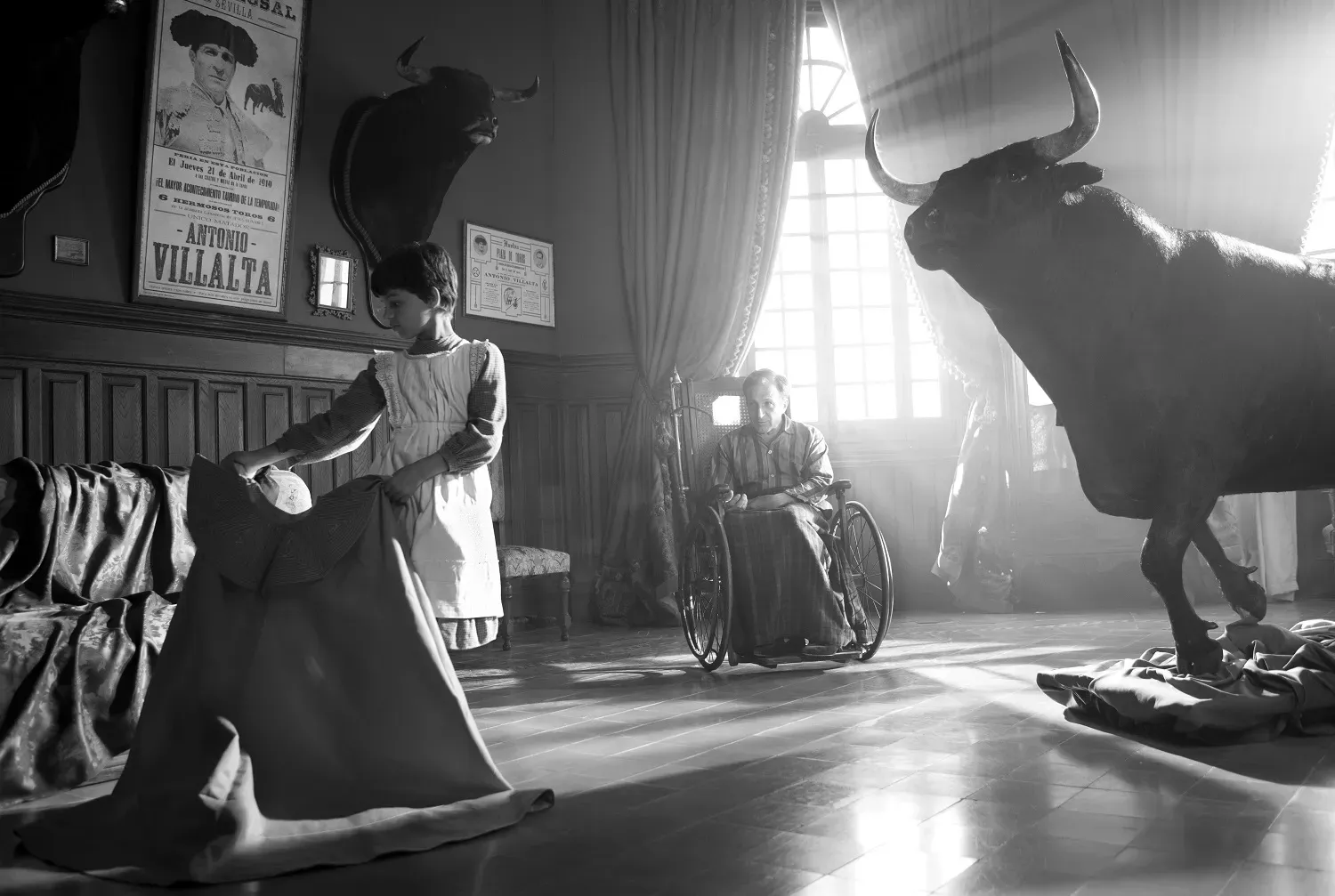
That the movie has no spoken dialogue and a relative handful of interstitials likewise allows it to dispense with verbose explanations. Characters behave with big, expressive emotions, with an assist from Alfonso de Vilallonga's playful tone poem score. As is often the case the wicked stepmother is best in show, with Maribel Verdú playing beauty and beast, communicating the character's wicked intent with carnivorous stares. There's not a weak link in the cast, but what keeps everything together is, for once, the dwarfs, played by actual little people, with some of them even being featured characters. Moreover they serve an actual function here; they are not just Carmen's fun new friends, they are her new family. They are integral to the later plot developments, including the melancholy epilogue.
If there is an element besides the source material that ties Pablo Berger's take on Snow White with Walt Disney's, it's that they both are creative efforts above all.
A full-length animated movie was unprecedented in 1937 and potentially ruinous investment, and while Blancanieves isn't breaking new ground, it is similarly unconcerned with commercial appeal. That is not the case with even the better of the four other adaptations that out the year it did.
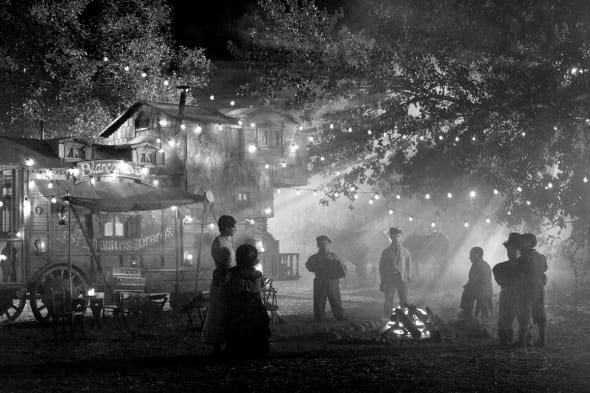
III. Twice Upon a Time
Snow White and the Huntsman
(dir. Rupert Sanders, 2012)
Mirror Mirror
(dir. Tarsem Singh, 2012)

If there were a single reason that 2012 saw so many Snows White, it would be the runaway success of Tim Burton's live-action Alice in Wonderland. Raking in just over a billion dollars, it led Hollywood producers to believe fairy tales were the hot new trend. Snow White and the Huntsman, produced by Alice producer Joe Roth, was first written long before, in 2003, when screenwriter Evan Daugherty was still an NYU undergrad. This is obvious in retrospect, with the movie's obvious visual debt to Peter Jackson's Lord of the Rings trilogy that concluded that year, but it also explains Huntsman's commitment to the bit. It's self-serious to a fault, but given that The Avengers was about to patient zero the plague of self-conscious quippiness on the blockbuster world, Huntsman's willingness to not condescend to the material and keep a straight face is admirable.
As is the case with all the adaptations, the bones of the Snow White story are the same but the meat and sinews different. Our wicked Queen, here named Ravenna (Charlize Theron), has usurped the throne of the kingdom of Tabor and has for years maintained her youth by feeding on the vitality of the kingdom's maidens. When the old king's daughter Snow White (Kristen Stewart) comes of age, Ravenna's mirror (Chris Obi) tells her that the young girl's heart may either destroy her or break the cycle of consumption. The Hunter (Chris Hemsworth) sent to kill her becomes her protector instead, and together they make their way to safety and, eventually, to overthrow Ravenna.
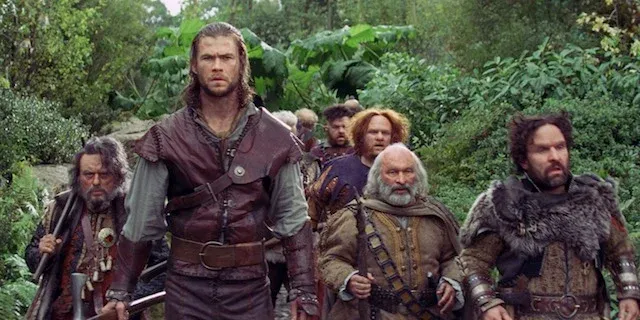
This is all very metal, and for a while that's good enough, especially with Ravenna as the load-bearing pillar of the movie. Theron's imperious rage is complemented by the baroque costuming, and most of the Cool Shit in the special effects revolves around her. The liquid gold mirror man, an army of glass warriors, a marble bath? Yes please. Sucking out the souls of young waifs like a Mortal Kombat character? Hell yes. An unkindness of ravens splatting onto the floor with Ravenna emerging covered in black muck and dead birds? That's cinema.
The "dwarfs," are what start to drag the movie down. They are played by a murderer's row of English talent (including Nicholas Frost, Ray Winstone, Toby Jones, and Bob Hoskins in his final role), whose faces have been digitally grafted on to little bodies. It's not just that this looks unnatural and is an insult to little person actors, though it definitely is. But even setting that aside, the dwarfs as written are just adding to a movie that's already overstuffed. There's Ravenna's creepy miniboss brother Finn (Sam Spruell), a prince charming love interest (Sam Claflin), and a whole Enchanted Forest sequence that's ripped straight out of Princess Mononoke. It very much feels like a movie with two additional credited screenwriters.
Snow White and the Huntsman is a nice diversion for those who like their fantasy a little grotty. For those who like it more florid, they got a movie in 2012 too.
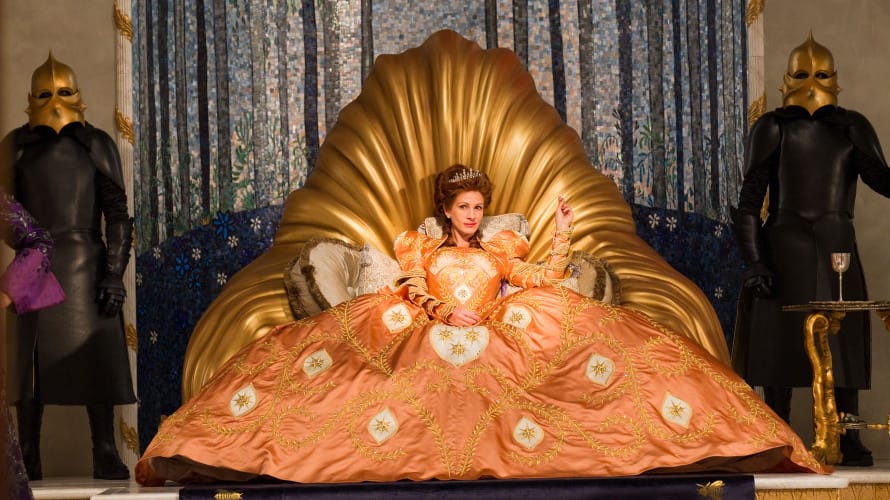
Of all of these, Mirror Mirror is the biggest (positive) surprise. While its humor risks being condescendingly snarky, it is instead best described as 'frivolous.' The story is filtered through the perspective of the Evil Queen (Julia Roberts), who looks on its happenings with bored amusement, content to empty her kingdom's coffers on lavish spectacle until she comes up short and has to marry the rich Prince of Valencia (Armie Hammer), who unfortunately is smitten with her stepdaughter Snow White (Lily Collins). There is a difference between the movie not taking its storytelling seriously and the Queen not taking the other characters seriously; Mirror Mirror stays on the right side of that line, allowing the audience to identify with and share in her indulgence.
And what indulgence! Tarsem Singh was previously beloved for the hallucinatory dreamscapes of The Cell and The Fall, but because this is a fairy tale the fantastical imagery is instead playful and whimsical, with gilded marble pillars twisted up like glazed breadsticks, retractable stilts for dwarfs to disguise themselves as giants, and a royal ball where every participant's outfit is themed after a different animal.
This was the swan song of legendary costume designer Eiko Ishioka, and she included an actual swan in a scene with a song.
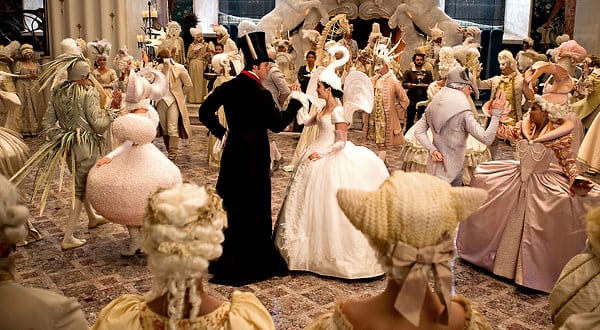
The actors are all there to be beautiful and entertaining, and they do their jobs well. The dwarfs, as with Blancanieves cast actual little people and makes them a part of the story (they start off as bandits robbing the Queen's carriages). I was never the biggest Armie Hammer fan even before the bizarre cannibalism rumors (and sexual abuse) imploded his career, but the Prince is exactly the kind of smug douchebag that Hammer excelled at playing, and he is game for looking extremely as the movie goes on. Lily Collins is fine as the titular character, but unremarkable, which is the fate of most Snows White.
Neither Snow White and the Huntsman nor Mirror Mirror are high art, but they entertain in their own ways. That's what the Hollywood machine was built for. But if Hollywood exists for escapism, the things that feed off that system might be called trapism. For when something is made not to be enjoyed but be purchased by tricking the buyer, how is that not a trap?
IV. Who's the Garish One of All?
Grimm's Snow White
(dir. Rachel Lee Goldenberg, 2012)
Snow White: A Deadly Summer
(dir. David DeCoteau, 2012)
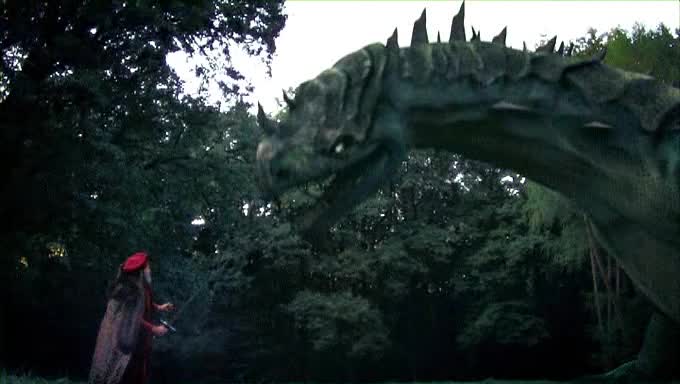
For as long as there have been commercial films there have been knock-offs. Cheap, shabby and often disreputable, it's easy to turn one's nose at them as parasites feeding off better movies, like I just did. But remove quality from the equation, and the similarities become apparent: trend-chasing, exploitation, the bottom line. Rather than something separate and different, the ripoff artists are a shadow of the industry, their shady advertising belying their forthrightly mercenary intentions.
No company has industrialized the process so thoroughly as The Asylum. Originally just another production company, by the mid 2000s they had found their niche capitalizing on American blockbusters by producing ersatz doppelgangers as cheaply as possible and getting them on video store racks before the real thing releases. It may not be accurate to say they are misrepresenting themselves. Nobody under the age of 40 would stumble on Transmorphers or Snakes on a Train and not know what they're getting themselves into, and by the time we got to 2013's Sharknado everybody was in on the joke.
That was still a year away. In the meantime Grimm's Snow White was released February 12, 2012 to capitalize on Snow White and the Huntsman's impending premiere three months later. Yet rather than being merely a lazy fairy tale retread as the title might suggest, it actually tries to copy Huntsman's gimmick and be a big Tolkienesque fantasy film, albeit on a ten-thousandth of its budget.
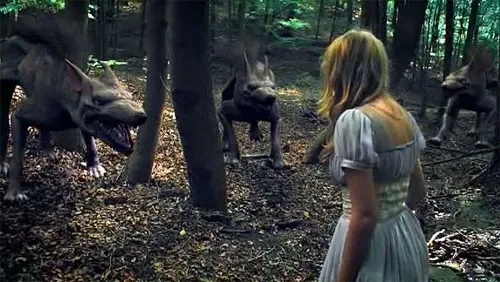
The movie is at its best in its opening, not because it is doing anything good but because each newly introduced plot element hits like an aneurysm. To wit: long ago a star fell to Earth. There arose from it a race of giant reptiles, and also elves, who were tortured and enslaved by humans. One day The King (Eberhard Wagner) is killed by a giant lizard. There follows a love triangle between evil Queen Gwendolyn (Jane Marsh), neighboring Prince Alexander (Jamie Thomas King), and Snow White (Eliza Bennett), shades of Mirror Mirror. The young woman is sent into the woods, whereupon she meets seven(?) elves, after which the usual Snow White plot kicks in with some dreadful high fantasy boilerplate and absolutely none of the resources needed to realize it.
The most expensive thing about the movie is that it was filmed in Austria, and even then its locations were mostly donated. The Queen's castle is clearly just a real castle, the Renaissanceschloss Rosenburg, but one maintained for tourism. Costumes are Spirit Halloween level, the props rudimentary. Makeup is so cheap that not only are the elf ears a different skin tone from the actors, in some shots the prosthetics are visibly detaching. The giant CGI lizard and dogs are just the shittiest-looking things. There is no bridging the gap between the production values necessary to bring the crummy script to life and what there actually is.
Blancanieves makes me look at cinematic artifice with wonder. Grimm's Snow White makes me wonder why we buy into the cinematic illusion at all. It doesn't look like a fantasy film, but rather a film of people pretending they're in a fantasy film. That gives it a certain charm for sure, and many of the people involved had actual careers before and after this. That doesn't stop it from looking like porn but without the screwing, and that's just a bad place to be. It is not, however, the worst.
There are no sex scenes in Snow White: A Deadly Summer either, but it was made by an actual pornographer, David DeCoteau.
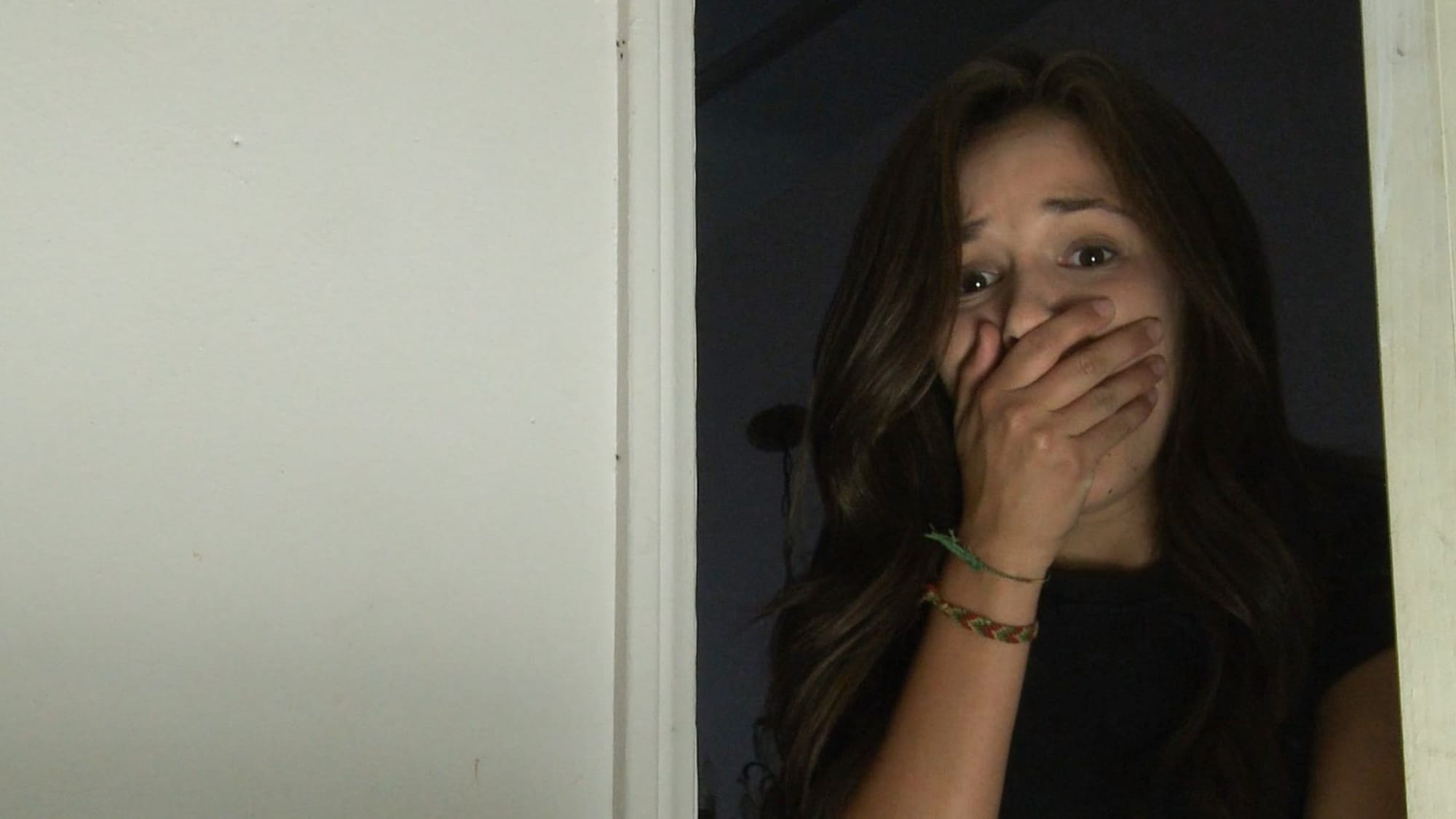
A disciple of low-budget legend Roger Corman, DeCoteau got his start back in the 80s directing gay skin flicks like Body Scorcher and Mansplash before graduating to proper schlock–his most popular film on Letterboxd is called Sorority Babes in the Slimeball Bowl-o-Rama–and eventually spreading his wings to encompass cheapies ranging from bad movie all-timer A Talking Cat!?! to a series of Lifetime movies starring Vivica A. Fox whose titles all start with "The Wrong" (The Wrong Roommate, The Wrong Child). DeCoteau is upfront about his creaive promiscuity, his ability to deliver whatever a client or the market demands, on time and within both budget and, for a few years, a surrealistically decorated Malibu beachhouse, which is how he has directed a staggering 176 films across four decades.
I only learned all of this after watching Snow White: A Deadly Summer, which by normal standards is mind-meltingly bad. The plot framework of evil stepmother Eve (Maureen McCormick) marrying the father (Eric Roberts) of teenage hellion Snow (Shanley Caswell) is basically a pretext to get Snow sent to a reform camp run by hardass drill instructor Hunter (Tim Abell). There she learns that years ago a camper was murdered, and wouldn't you know it, the movie turns into a quasi-slasher as soon the seven other campers in Snow's cohort start getting picked off–though not before Snow has premonitions of their deaths, done in some of the most atrocious day-for-night ever shot for a commercial release. (I filmed scenes that looked this bad as an undergrad, for free, so I reserve the right to judge.)
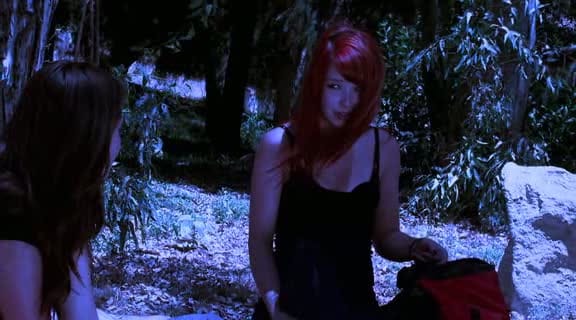
The blown-out video is also present during the daytime scenes, which look like they were shot at high noon for minimum white balance—this is but one crime against both art and craft. The sound is abysmal, peaking and distorting whenever characters yell, which is not infrequent. The dialogue includes exasperating winks to the fact that the characters are living out a fairy tale, but also bad-movie gems like "I'll beat the white off your snow white ass" and this exchange between two campers and a third going through withdrawal:
"Anything we can do?"
"Not unless you've got a gun so I can blow my brains out."
"It's what my daddy always says, drugs are for the weak."
Of the actors, Eric Roberts is the most incongruously famous, but it is Marcia Brady herself, Maureen McCormick, who gives the most memorable performance, one which climaxes with the most disinflected delivery of the word "me" in cinematic history, twice.
It all wraps up in a twist that can only be described as "reverse Oz." That this nonsensical twist is supported visually by the cast—who all were all in black T-shirts and now wear white—is what finally convinced me that David DeCoteau is not a mere troll or hack but an idiot savant of cinema.
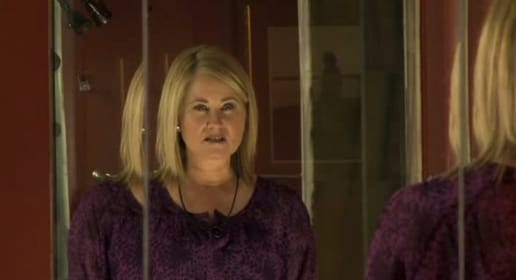
It's a slight but important distinction. Intentional trash of the kind The Asylum produces have a surface-level ironic appeal, but after the novelty wears off they're just bad movies made worse by their self-awareness. DeCoteau's get-the-job-done work ethic leaves no time for color temperature much less ironic posturing, and so his movies are a purer, more honest dreck. I marvel at his career as an ecologist might marvel at a dung beetle for how perfectly built it is to thrive on shit.
Lest you judge all this too harshly, consider that today's film industry has become just as calculated and risk-averse. Yet instead of just making their cash-ins cheap like sensible slopper barons, the major studios inflate their budgets to pay for celebrity cache and pixel-fucked visual effects. The result is too competent to be outright shit; it is instead an ugly algorithmic sludge. Or maybe just piss.
V. Don't Eat the Yellow Snow
Snow White
(dir. Marc Webb, 2025)
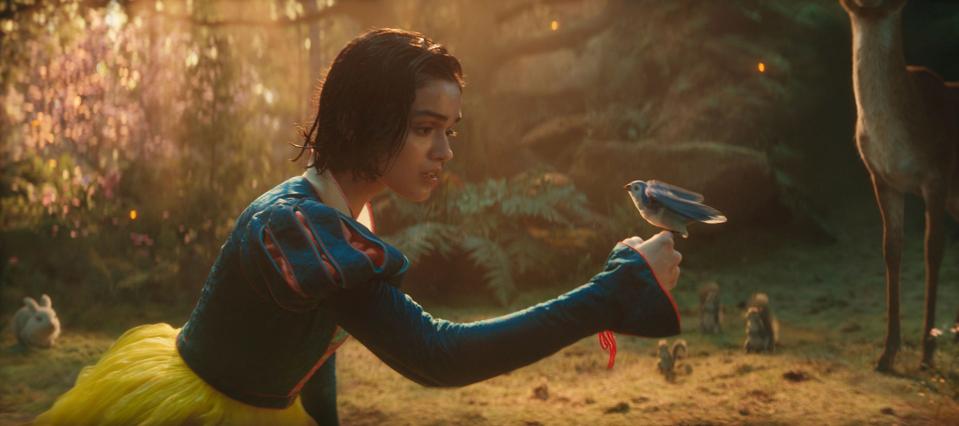
The 1937 Snow White and the Seven Dwarfs opens with a thank-you note from Walt Disney to the animators which, the man's union-busting aside, goes to show how much he valued their work. The company that bears his name today pays lip service to their legacy of world-class animation, but routinely spends hundreds of millions of dollars to travesty them instead. Disney has released between 23 and 26 remakes of its animated canon that are nominally live-action but are wholly dependent on photoreal computer animation, rendering the classics' imaginative cartoon style and storybook logic in the most dully literal fashion.
Weighed against the most recent of these, Disney's remake of its 1937 film is middling: it doesn't trigger the ontological dyphoria of "I'm a Star" in Wish or the visceral repulsion of watching a photoreal mermaid fall into a mass of jellyfish in The Little Mermaid, but neither does it have the tragic interest of an auteur trying to find artistic purchase within a purely commercial enterprise as Barry Jenkins was with Mufasa. The one-two punch of the direct-to-video Snows White had also drastically recalibrated my idea of a bad movie before I saw it, so Snow White 2025 was going to be better practically by default. As it is I didn't like it but I didn't despise it either.
The plot is largely the same as it was in 1937, but there's more of it. The storybook prologue has been expanded to a whole introductory song and backstory, explaining Snow White's (Rachel Zegler) loss of her mother, the coming of her Evil Queen stepmother (Gal Gadot), the deterioration of the unnamed kingdom after she usurps the throne. The prince charming character has been swapped out for Jonathan (Andrew Burnap), the leader of a group of bandits who have popped up in the woods since the kingdom went to the dogs, and then the dwarfs....
So, look, the dwarfs are terrible; repulsive, gnomish caricatures given horrific clarity, like one of those 'realistic Homer Simpson' shitposts played straight. Dopey is maybe the least overtly gross, but he still looks like a Midjourney Alfred E. Neuman.
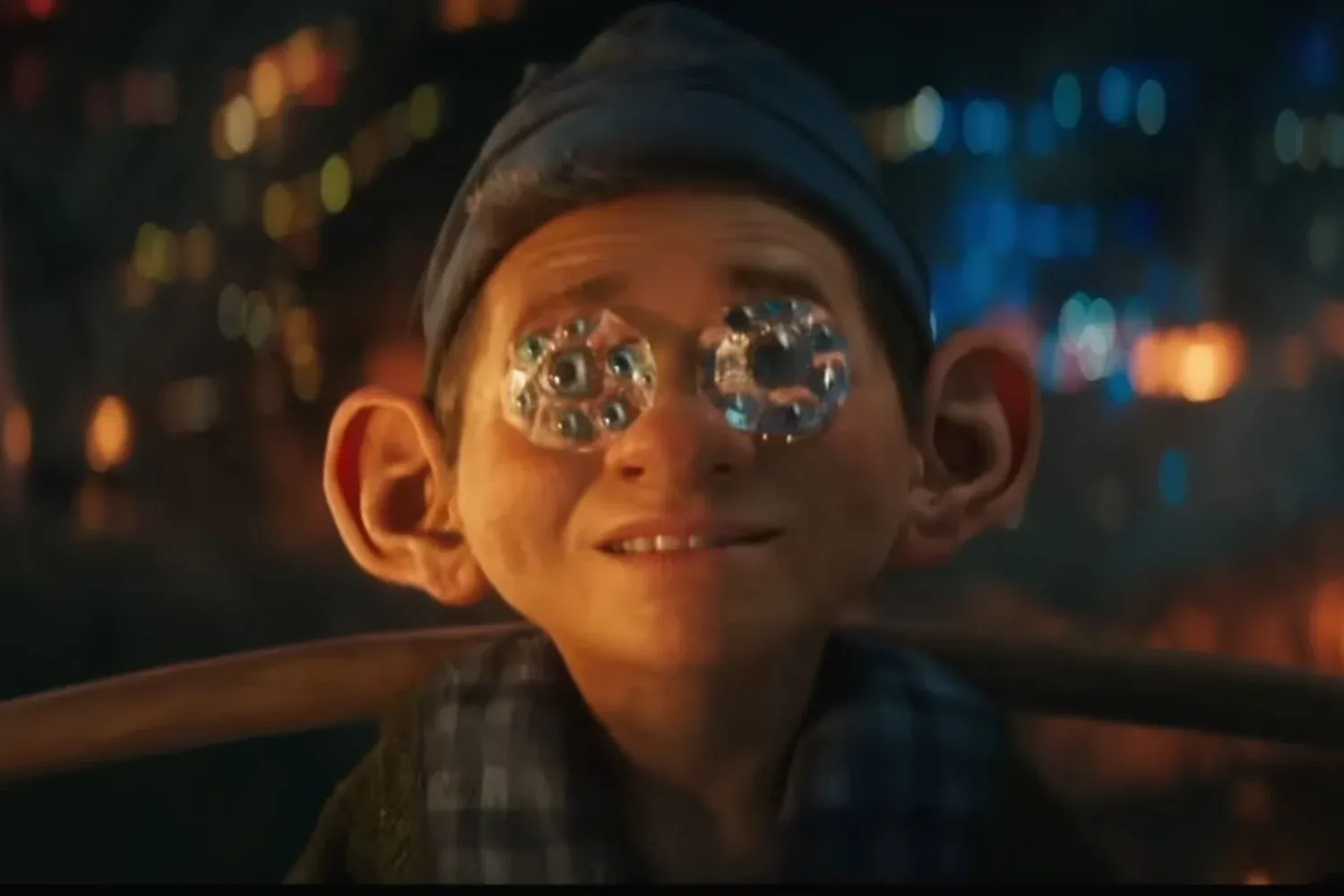
But we've known all this since at least August 2024, when the teaser trailer became one of the most disliked videos on YouTube. Even though the dwarfs look like a ruined and terrible form of life, they are at least a known quantity. More damaging is the Vaseline-slick CGI sheen over the entire movie, and its Pixie Stix color palette that makes everybody look like the most expensive cosplayers ever. Grimm's Snow White was unable to create any illusion of a fantasy world because it had no budget. Webb's Snow White has the same problem but for the opposite reason, effectively unlimited funds with no direction except to make it look like the original animated movie.
The mostly new songs are not terribly memorable, but neither are they memorably terrible. I'll even go so far to say the opener, "Good Things Grow," and Snow White's 'I Want' song "Waiting on a Wish" are pleasant if generic entryways into the story. I'll go even further to say the Evil Queen's number, "All is Fair," is actively good, at least on paper, with lyrics that capitalize on a triple meaning--fairness as in justice, love and war, and beauty. I can see these songs working in the inevitable Broadway adaptation. Unfortunately Gal Gadot is not a Broadway singer, and because the movies today can feature grotesque computer-generated goblins and call them people but cannot ever dub over an actor's singing voice, her vocals are strained and unmodulated.
Gadot fares better outside the musical numbers, though she is mostly doing the same business as Charlize Theron did but with weaker material. Rachel Zegler is a singer and brings needed credibility to the songs, and also makes an appealing Snow White. She is the one unambiguous improvement over the original. It's funny but not haha funny that her post's supporting Palestinian and criticizing Donald Trump are being blamed for the movie's underperformance at the box office; funny because of Donald Trump's vengeful attacks on Disney and Gadot's own advocacy for Israel's ruinous Gaza war, and because this real-world conflict recapitulates the basic conflict of the film.
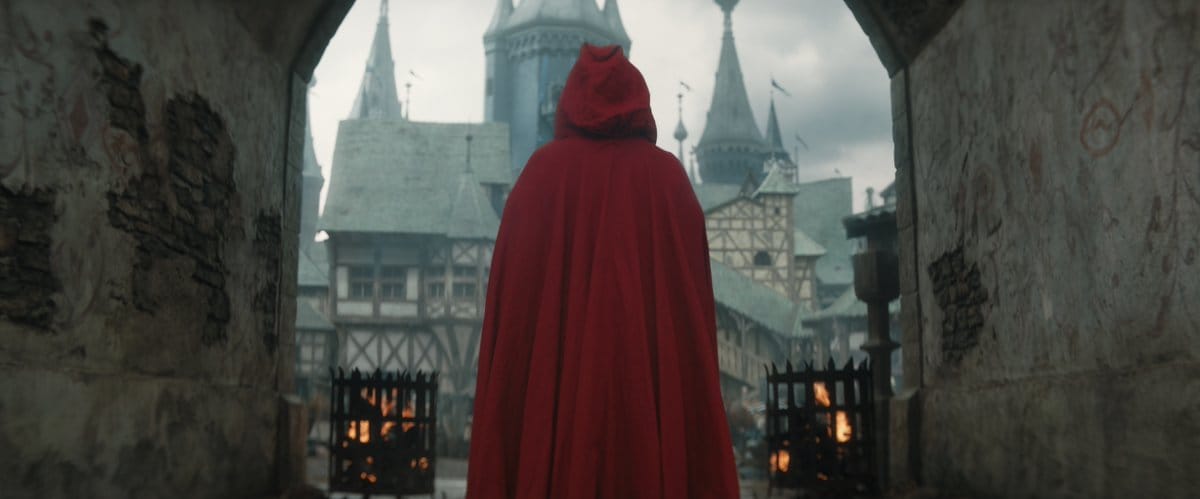
Yes, screenwriter Erin Cressida Wilson has interpreted Snow White as an antifascist parable, climaxing with Snow White, paragon of kindness–the fairest, you see–marching like a fairy tale Navalny against the Queen, who rules with diamond-hardness of heart. And you know what, that's fine. Good, even. Guillermo Del Toro did it for Pinocchio, and he made a goddamn masterpiece. But then Guillermo del Toro is an artist with a point of view and a vision that comes through in every frame he shoots. Marc Webb is a hired gun, which serves him well enough in television but for big budget cinema gave us Sony's two dreary placeholder Spider-Man movies. His direction here is slack, rushing through the horror moments and making the beautiful tableaus of the original movie into uninspired slop. He has no discernable feelings about the material, so it all just comes off insincere as well as wildly incongruous, like an HR official using Disney princess dolls for a theater kid's Popular Front role-play.
I've seen how bad Snow White adaptations and late Disney slop can be, so I'm relieved the movie made me roll my eyes rather than want to gouge them out. But there still is no real reason for this thing to exist. It is not even bad. Walt Disney bet his entire company on Snow White and the Seven Dwarfs because his restless creativity demanded it. The Walt Disney Company assembled Snow White 2025 out of formulaic corporate mandate. The apple may look sweet, but by now we know better. We've seen this movie before.

Enjoyed the read? Subscribe for free and get the next one as soon as it's published! If you know someone who would enjoy it, share the link. And if you want to support Cinema Purgatorio, any tips I receive will help to offset hosting costs. Any support is appreciated.
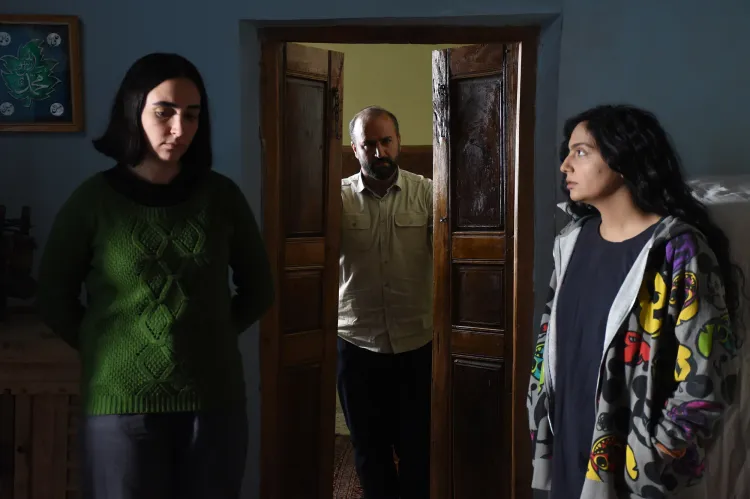


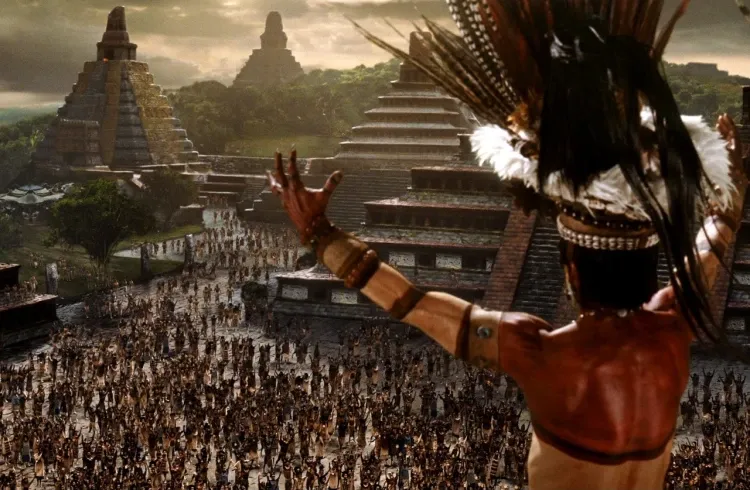

Member discussion